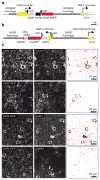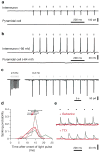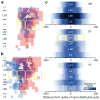The columnar and laminar organization of inhibitory connections to neocortical excitatory cells
- PMID: 21076426
- PMCID: PMC3011044
- DOI: 10.1038/nn.2687
The columnar and laminar organization of inhibitory connections to neocortical excitatory cells
Abstract
The cytoarchitectonic similarities of different neocortical regions have given rise to the idea of 'canonical' connectivity between excitatory neurons of different layers within a column. It is unclear whether similarly general organizational principles also exist for inhibitory neocortical circuits. Here we delineate and compare local inhibitory-to-excitatory wiring patterns in all principal layers of primary motor (M1), somatosensory (S1) and visual (V1) cortex, using genetically targeted photostimulation in a mouse knock-in line that conditionally expresses channelrhodopsin-2 in GABAergic neurons. Inhibitory inputs to excitatory neurons derived largely from the same cortical layer within a three-column diameter. However, subsets of pyramidal cells in layers 2/3 and 5B received extensive translaminar inhibition. These neurons were prominent in V1, where they might correspond to complex cells, less numerous in barrel cortex and absent in M1. Although inhibitory connection patterns were stereotypical, the abundance of individual motifs varied between regions and cells, potentially reflecting functional specializations.
Conflict of interest statement
COMPETING FINANCIAL INTERESTS
The authors declare no competing financial interests.
Figures







References
-
- Mountcastle VB. An organizing principle for cerebral function: The unit module and the distributed system. In: Mountcastle VB, Edelman GM, editors. The mindful brain. MIT Press; Cambridge: 1978. pp. 7–50.
-
- Koralek KA, Jensen KF, Killackey HP. Evidence for two complementary patterns of thalamic input to the rat somatosensory cortex. Brain Res. 1988;463:346–351. - PubMed
Publication types
MeSH terms
Substances
Grants and funding
LinkOut - more resources
Full Text Sources
Other Literature Sources
Molecular Biology Databases

